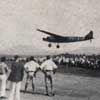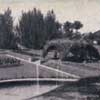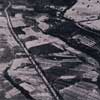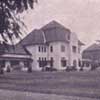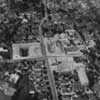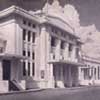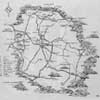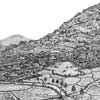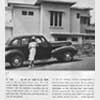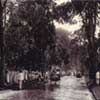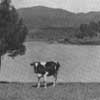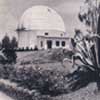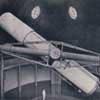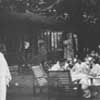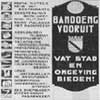|
Bandung, a Garden City [english|indonesia] Bandung is a thoroughly up-to-date mountain city, the principal town of the Preanger, and is situated among more of the beauties of Java than any other city here. It is most attractively laid out with wide streets and imposing buildings, while the residences pride themselves on their gardens. It is connected with the outside world by road, rail, and air. From Batavia it is reached by the four daily expresses known as the "Vlugge Vier" each taking about two and three quarters of an hour; by road it takes from three to four hours driving ; the aero planes of the K.N.I.L.M, fly the distance in about three quarters of an hour. This flight offers two of the most delightful sights in the Netherlands Indies. First, if Bandung is left by the early morning plane, it is a gorgeous sight to watch the sun slowly creeping down the slides of the surrounding mountains, most vived red in color picked out in greens and yellow, and when seen from above this is a sight to delight an artist. Secondly, when circling the city prior to landing or just after taking off in the afternoon flight the parks and gardens present another mass of color against the more dark background of streets and buildings. It has been said that the Netherlands Indies is a land of color, and seldom is this better realized than when viewing Bandoeng and its environs from the air. It is perfectly true that Bandung offers the visitors "the comfort of the West married to the romance of the East".
Several Departments of the Government are situated in this city, which also houses the University School of Engineering and the Pasteur Institute. Here, too, is the world renowned Bandung Quinine Factory, whose life-saving pills are distributed throughout the length and breadth of the Orient. The raw material comes from the many cinchona estates in the hills around the city. The Netherlands Indies produces over 97% of the world's supply of this product.
Bandung is a city of gardens and parks, and sightseeing is a delight in such a pleasantly cool climate. The hotels are excellent and the Club hospitable to properly introduced visitors. As a shopping city Bandung is quite attractive.
Bandung is also particularly blessed in its environs. Lying, as described above, at the bottom of a cup surrounded on all sides by mountains, it is ringed with lovely little hill stations, to mention all of which by name would take too much space. Two which deserve special mention, however, are Dago, really a suburb built up continuously with Bandung but at a considerably higher level than the city proper (Bandung is about 630 m above sea level, Dago rises to about 900 m), and Lembang, a delightful little village half way up the Tangkuban Prahu volcano, renowned for its magnificent dahlias and other flowers. At Dago is a pleasant tea room on a terrace overlooking the city and it is a particularly pretty sight in the cool of the evening to watch the lights of Bandung flicker on one by one in the valley below. At Lembang are numerous villas and several good hotels, by no means unreasonable in price; in fact it is one of the least expensive mountain resorts lying near a large city (about twenty minutes from the center of Bandung).
The best way to learn the real beauties of the surrounding of Bandung is to step in a motor car and ride, in any direction at all, out the city along the excellent Preanger roads. Within a few minutes the visitor is in the midst of mountains, beside some lovely waterfall, confronted by chalk cliffs or granite rocks, with here and there mysterious caves. There are two trips that are unique, as far as is known, in the world, namely those to the craters of the Tangkuban Prahu, above Lembang, and to the crater filed of the Papandayan. The road to the first passes Lembang and shortly afterwards begins to wind upwards along a tortuous toll road which ends in a parking place for cars actually on the brink of a crater some hundreds feet deep. The mountain boasts of three craters in all paths lead to the others from the parking place. On a clear day the view is magnificent, but since he is on the top of a mountain, the visitor must not be disappointed if he finds himself actually in the clouds. The road to the Papandayan crater field is newer, but there is even more to interest the visitor at its end than there is at the Tangkuban Prahu. At the Papandayan are solfaltaras, mud craters bubbling and churning eternally, even a geyser or two, as well as the craters themselves which are reached from the parking place by a path of a hundred yards or so long.
Along other roads lies the Cisarua Waterfall. An excursion by car to the Kawah Putih and the summit of the Patuha (2190 m) is also to be recommended. From this summit, which may be reached after short walk, the India Ocean can be seen in clear weather. The road leads from Bandung via Soreang - Ciwidey to Ranca Bolang and back via Ranca Bali to Lake Patengan. The total length of this trip there and back is about 127 km or 78 miles. The roads runs by way of Pacet, Pangalengan, and little side trip to Cileunca is possible.
One other thing remains to be seen before leaving Bandung: to wit the Bosscha Observatory near Lembang, which houses the largest telescope in the southern hemisphere.
It must not be forgotten that we are describing not the trip of a single tourist who must hurry through Java in a few days, but the principal objects of interest in and around the various centers touched upon. Bandung cannot be "done" in a day, and the traveler whose time is limited must choose with care from the banquet of interest and beauty that is offered him. A program for a single day in Bandung would be roughly as follows. Arrive in the afternoon (by train, car, or plane); take tea at Dago and watch the city light up. Spend the evening in the shopping streets. Early next morning take a trip to the Tangkuban Prahu (the mountain is less likely to be clouded in the very early morning). Return and stop off in Lembang for flowers and visit the Observatory (permit to be arranged for in advance). Drive through the lovely Bandung streets and lunch at the hotel. TMY
August 2001
|
